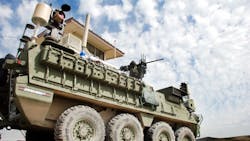Air defenses are a constant concern and need for the U.S. Army, to the extent that the armed forces try to evaluate the latest offensive/defense technologies, such as directed-energy weapons. The Army is hoping to soon complete a current evaluation being held at White Sands Missile Range, NM with possible use as part of an Integrated Air and Missile Defense Battle Command System (IBCS) capability. A Patriot missile unit will be the first unit equipped with the IBCS and operational by 2022 once the user testing has concluded (see figure). It is hoped that the IBCS architecture will support continuous communications between the highest headquarters and the weapon operator.
The Army is exploring different types of directed energy weapons, including high-energy-laser (HEL) and high-power microwave (HPM) systems. According to Lieutenant General Neil Thurgood, director of hypersonics, directed energy, space, and rapid acquisition at the Army Rapid Capabilities and Critical Technologies Office (RCCTO), the RCCTO is charge with fielding enabling technologies that address near-field and mid-field threats: “The world has changed over the last 18 or 19 years as we have been fighting the global war on terror. With the signing of the National Defense Strategy, the Army is now in an era of great power competition against China and Russia.”
The Army is working on fielding directed energy-maneuver short range air defense (DE-MSHORAD) capability to the platoon level by fiscal 2022. The capability provides brigade combat teams with a 50-kW laser aboard a Stryker combat vehicle to support air defense artillery operations. The Army is also looking to field a 300-kW indirect fire protection capability-high energy laser (IFPC-HEL) and IFPC-high-powered-microwave (HPM) system at the platoon level in fiscal 2024.
Directed energy weapons are considered cost effective and a strategic tool in the fight against low-cost weapons. Thurgood observed: “At these power levels, I colloquially remind people that we don't have the ‘Star Wars effect’—where you put a beam of light out there and a battleship blows up. Directed energy is a very specific weapon for specific outcomes.”
About the Author
Jack Browne
Technical Contributor
Jack Browne, Technical Contributor, has worked in technical publishing for over 30 years. He managed the content and production of three technical journals while at the American Institute of Physics, including Medical Physics and the Journal of Vacuum Science & Technology. He has been a Publisher and Editor for Penton Media, started the firm’s Wireless Symposium & Exhibition trade show in 1993, and currently serves as Technical Contributor for that company's Microwaves & RF magazine. Browne, who holds a BS in Mathematics from City College of New York and BA degrees in English and Philosophy from Fordham University, is a member of the IEEE.
